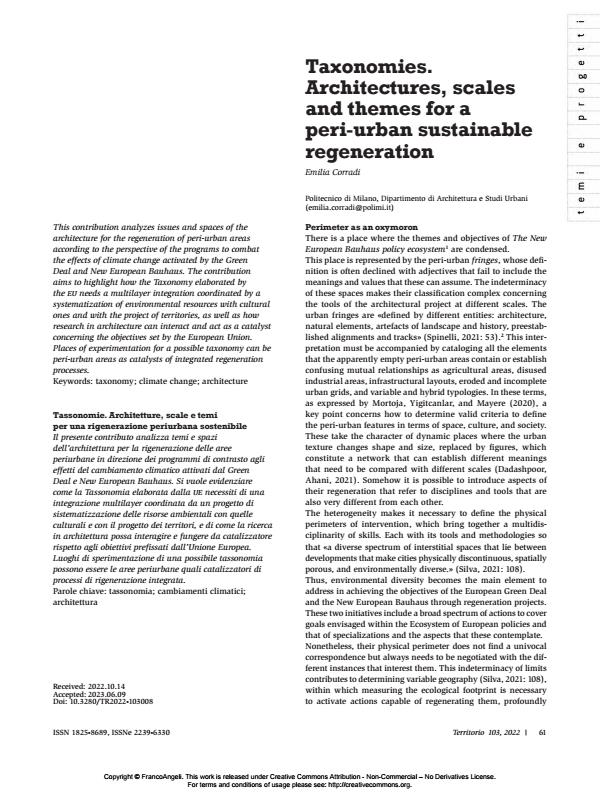Taxonomies. Architectures, scales and themes for a peri-urban sustainable regeneration
Titolo Rivista TERRITORIO
Autori/Curatori Emilia Corradi
Anno di pubblicazione 2023 Fascicolo 2022/103
Lingua Inglese Numero pagine 6 P. 61-66 Dimensione file 197 KB
DOI 10.3280/TR2023-103008
Il DOI è il codice a barre della proprietà intellettuale: per saperne di più
clicca qui
Qui sotto puoi vedere in anteprima la prima pagina di questo articolo.
Se questo articolo ti interessa, lo puoi acquistare (e scaricare in formato pdf) seguendo le facili indicazioni per acquistare il download credit. Acquista Download Credits per scaricare questo Articolo in formato PDF

FrancoAngeli è membro della Publishers International Linking Association, Inc (PILA)associazione indipendente e non profit per facilitare (attraverso i servizi tecnologici implementati da CrossRef.org) l’accesso degli studiosi ai contenuti digitali nelle pubblicazioni professionali e scientifiche
This contribution analyzes issues and spaces of the architecture for the regeneration of peri-urban areas according to the perspective of the programs to combat the effects of climate change activated by the Green Deal and New European Bauhaus. The contribution aims to highlight how the Taxonomy elaborated by the eu needs a multilayer integration coordinated by a systematization of environmental resources with cultural ones and with the project of territories, as well as how research in architecture can interact and act as a catalyst concerning the objectives set by the European Union. Places of experimentation for a possible taxonomy can be peri-urban areas as catalysts of integrated regeneration processes.
Il presente contributo analizza temi e spazi dell’architettura per la rigenerazione delle aree periurbane in direzione dei programmi di contrasto agli effetti del cambiamento climatico attivati dal Green Deal e New European Bauhaus. Si vuole evidenziare come la Tassonomia elaborata dalla ue necessiti di una integrazione multilayer coordinata da un progetto di sistematizzazione delle risorse ambientali con quelle culturali e con il progetto dei territori, e di come la ricerca in architettura possa interagire e fungere da catalizzatore rispetto agli obiettivi prefissati dall’Unione Europea. Luoghi di sperimentazione di una possibile tassonomia possono essere le aree periurbane quali catalizzatori di processi di rigenerazione integrata.
Parole chiave:tassonomia; cambiamenti climatici; architettura
Emilia Corradi, Taxonomies. Architectures, scales and themes for a peri-urban sustainable regeneration in "TERRITORIO" 103/2022, pp 61-66, DOI: 10.3280/TR2023-103008